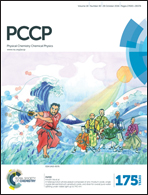Raman excess spectroscopy vs. principal component analysis: probing the intermolecular interactions between chiral molecules and imidazolium-based ionic liquids
Abstract
Raman spectroscopy is a very sensitive and specific measurement tool for probing intermolecular interaction structures. As imidazolium-based ionic liquids can favorably be used for enantioseparation, in this work two approaches for Raman signal analysis, namely by means of excess spectra and principal component analysis (PCA), are compared to extract detailed information about the interaction structure of the enantiomers D- and L-glucose in an aqueous solution of the ionic liquid [EMIM][EtSO4]. In contrast to the excess calculations, the loadings obtained from PCA lead to significant results since the interactions are weighted by their strength and significance. Moreover, the analysis of the weighted vibrations in the loadings indicate that hydrogen bonds are particularly formed between the ethyl sulphate anion of [EMIM][EtSO4] and the hydrogen atom of the OH-group at the C6-atom of glucose.


 Please wait while we load your content...
Please wait while we load your content...